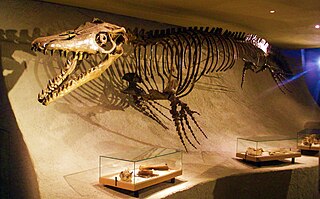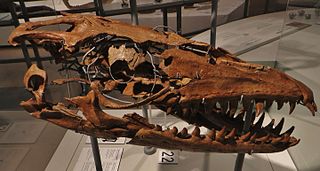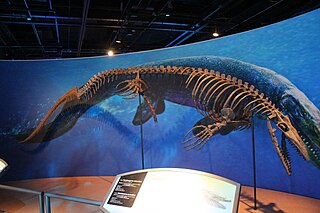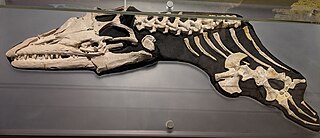
Mosasaurs are an extinct group of large aquatic reptiles within the family Mosasauridae that lived during the Late Cretaceous. Their first fossil remains were discovered in a limestone quarry at Maastricht on the Meuse in 1764. They belong to the order Squamata, which includes lizards and snakes.

Mosasaurus is the type genus of the mosasaurs, an extinct group of aquatic squamate reptiles. It lived from about 82 to 66 million years ago during the Campanian and Maastrichtian stages of the Late Cretaceous. The genus was one of the first Mesozoic marine reptiles known to science—the first fossils of Mosasaurus were found as skulls in a chalk quarry near the Dutch city of Maastricht in the late 18th century, and were initially thought to be crocodiles or whales. One skull discovered around 1780 was famously nicknamed the "great animal of Maastricht". In 1808, naturalist Georges Cuvier concluded that it belonged to a giant marine lizard with similarities to monitor lizards but otherwise unlike any known living animal. This concept was revolutionary at the time and helped support the then-developing ideas of extinction. Cuvier did not designate a scientific name for the animal; this was done by William Daniel Conybeare in 1822 when he named it Mosasaurus in reference to its origin in fossil deposits near the Meuse River. The exact affinities of Mosasaurus as a squamate remain controversial, and scientists continue to debate whether its closest living relatives are monitor lizards or snakes.
Tylosaurus is a genus of mosasaur, a large, predatory marine reptile closely related to modern monitor lizards and snakes, from the Late Cretaceous.

The Mosasaurinae are a subfamily of mosasaurs, a diverse group of Late Cretaceous marine squamates. Members of the subfamily are informally and collectively known as "mosasaurines" and their fossils have been recovered from every continent except for South America.
Plioplatecarpinae is a subfamily of mosasaurs, a diverse group of Late Cretaceous marine squamates. Members of the subfamily are informally and collectively known as "plioplatecarpines" and have been recovered from all continents, though the occurrences in Australia remain questionable. The subfamily includes the genera Latoplatecarpus, Platecarpus, Plioplatecarpus and Plesioplatecarpus.

The Halisaurinae are a subfamily of mosasaurs, a group of Late Cretaceous marine lizards. They were small to medium-sized, ranging from just under 3 meters in Eonatator sternbergi to as much as 8 or 9 meters in Pluridens serpentis. They tended to have relatively slender jaws and small, numerous teeth, suggesting a diet of small fish and other prey. Although the skeleton is primitive compared to other Mosasauridae in many respects, halisaurines had the distinctive hypocercal tail of other mosasaurids suggesting good swimming ability, and they persisted alongside other mosasaurs until the end of the Cretaceous. The earliest known remains of halisaurines occur in rocks of Santonian age and the subfamily persists until the latest Maastrichtian. Halisaurines are known from North and South America, Europe, Asia and Africa, indicating a more or less global distribution in the Late Cretaceous. Four genera are currently recognized: Eonatator, Halisaurus, Phosphorosaurus and Pluridens.
Platecarpus is an extinct genus of aquatic lizards belonging to the mosasaur family, living around 84–81 million years ago during the middle Santonian to early Campanian, of the Late Cretaceous period. Fossils have been found in the United States and possible specimens in Belgium and Africa. A well-preserved specimen of Platecarpus shows that it fed on moderate-sized fish, and it has been hypothesized to have fed on squid, and ammonites as well. Like other mosasaurs, it was initially thought to have swum in an eel-like fashion, although another study suggests that it swam more like modern sharks. An exceptionally well-preserved specimen of P. tympaniticus known as LACM 128319 shows skin impressions, pigments around the nostrils, bronchial tubes, and the presence of a high-profile tail fluke, showing that it and other mosasaurs did not necessarily have an eel-like swimming method, but were more powerful, fast swimmers. It is held in the Natural History Museum of Los Angeles County. Isotopic analysis on teeth specimens has suggested that this genus and Clidastes may have entered freshwater occasionally, just like modern sea snakes.

Prognathodon is an extinct genus of marine lizard belonging to the mosasaur family. It is classified as part of the Mosasaurinae subfamily, alongside genera like Mosasaurus and Clidastes. Prognathodon has been recovered from deposits ranging in age from the Campanian to the Maastrichtian in the Middle East, Europe, New Zealand, and North America.
Clidastes is an extinct genus of marine lizard belonging to the mosasaur family. It is classified as part of the Mosasaurinae subfamily, alongside genera like Mosasaurus and Prognathodon. Clidastes is known from deposits ranging in age from the Coniacian to the early Campanian in the United States.

Dolichorhynchops is an extinct genus of polycotylid plesiosaur from the Late Cretaceous of North America, containing the species D. osborni and D. herschelensis, with two previous species having been assigned to new genera. Specimens of D. osborni have been found in the early Coniacian to early Campanian rocks, while those of D. herschelensis have been found in the late Campanian to early Maastrichtian rocks. Dolichorhynchops was a prehistoric marine reptile. Its Greek generic name means "long-nosed face". While typically measuring about 3 metres (9.8 ft) in length, the largest specimen of D. osborni is estimated to have a total body length more than approximately 4.3 metres (14 ft).
Goronyosaurus is an extinct genus of marine lizard belonging to the mosasaur family. Fossils of Goronyosaurus are exclusively known from the Late Maastrichtian of the Iullemmeden Basin in West Africa, specifically the Dukamaje Formation of Niger and Nigeria and Farin Doutchi Formation of Niger. The type specimen was first described in 1930 as Mosasaurus nigeriensis, but subsequent remains revealed a highly unique set of adaptations that prompted the species to be reclassified as the only species of the new genus Goronyosaurus in 1972. These unique adaptations have made Goronyosaurus notoriously difficult to classify within the Mosasauridae and it is often left out of phylogenetic analyses, although most authors agree that Goronyosaurus belonged to Mosasauridae.

Taniwhasaurus is an extinct genus of mosasaurs that lived during the Campanian stage of the Late Cretaceous. It is a member of the subfamily Tylosaurinae, a lineage of mosasaurs characterized by a long toothless conical rostrum. Two valid species are attached to the genus, T. oweni and T. antarcticus, known respectively from the fossil record of present-day New Zealand and Antarctica. Two other species have been nominally classified within the genus, T. 'capensis' and T. 'mikasaensis', recorded in present-day South Africa and Japan, but their attribution remains problematic due to the fragmentary state of their fossils. The generic name literally means "taniwha lizard", referring to a supernatural aquatic creature from Māori mythology.

Liodon is a dubious genus of mosasaur from the Late Cretaceous, known from fragmentary fossils discovered in St James' Pit, England and possibly also the Ouled Abdoun Basin of Morocco. Though dubious and of uncertain phylogenetic affinities, Liodon was historically a highly important taxon in mosasaur systematics, being one of the genera on which the family Mosasauridae was based.

The Pierre Shale is a geologic formation or series in the Upper Cretaceous which occurs east of the Rocky Mountains in the Great Plains, from Pembina Valley in Canada to New Mexico.

Angolasaurus is an extinct genus of mosasaur. Definite remains from this genus have been recovered from the Turonian and Coniacian of Angola, and possibly the Coniacian of the United States, the Turonian of Brazil, and the Maastrichtian of Niger. While at one point considered a species of Platecarpus, recent phylogenetic analyses have placed it between the (then) plioplatecarpines Ectenosaurus and Selmasaurus, maintaining a basal position within the plioplatecarpinae.

During the time of the deposition of the Niobrara Chalk, much life inhabited the seas of the Western Interior Seaway. By this time in the Late Cretaceous many new lifeforms appeared such as mosasaurs, which were to be some of the last of the aquatic lifeforms to evolve before the end of the Mesozoic. Life of the Niobrara Chalk is comparable to that of the Dakota Formation, although the Dakota Formation, which was deposited during the Cenomanian, predates the chalk by about 10 million years.

This timeline of mosasaur research is a chronologically ordered list of important fossil discoveries, controversies of interpretation, and taxonomic revisions of mosasaurs, a group of giant marine lizards that lived during the Late Cretaceous Epoch. Although mosasaurs went extinct millions of years before humans evolved, humans have coexisted with mosasaur fossils for millennia. Before the development of paleontology as a formal science, these remains would have been interpreted through a mythological lens. Myths about warfare between serpentine water monsters and aerial thunderbirds told by the Native Americans of the modern western United States may have been influenced by observations of mosasaur fossils and their co-occurrence with creatures like Pteranodon and Hesperornis.

Kaikaifilu is an extinct genus of large mosasaurs that lived during the Late Cretaceous (Maastrichtian) in what is now northern Antarctica. The only species known, K. hervei, was described in 2017 from an incomplete specimen discovered in the López de Bertodano Formation, in Seymour Island, Antarctic Peninsula. The taxon is named in reference to Coi Coi-Vilu, a reptilian ocean deity of the Mapuche cosmology. Early observations of the holotype classify it as a member of the subfamily Tylosaurinae. However, later observations note that several characteristics show that this attribution is problematic.
This research history of Tylosaurus documents the historical developments in the study of Tylosaurus, a genus of extinct aquatic squamate reptile that lived during the Late Cretaceous.















